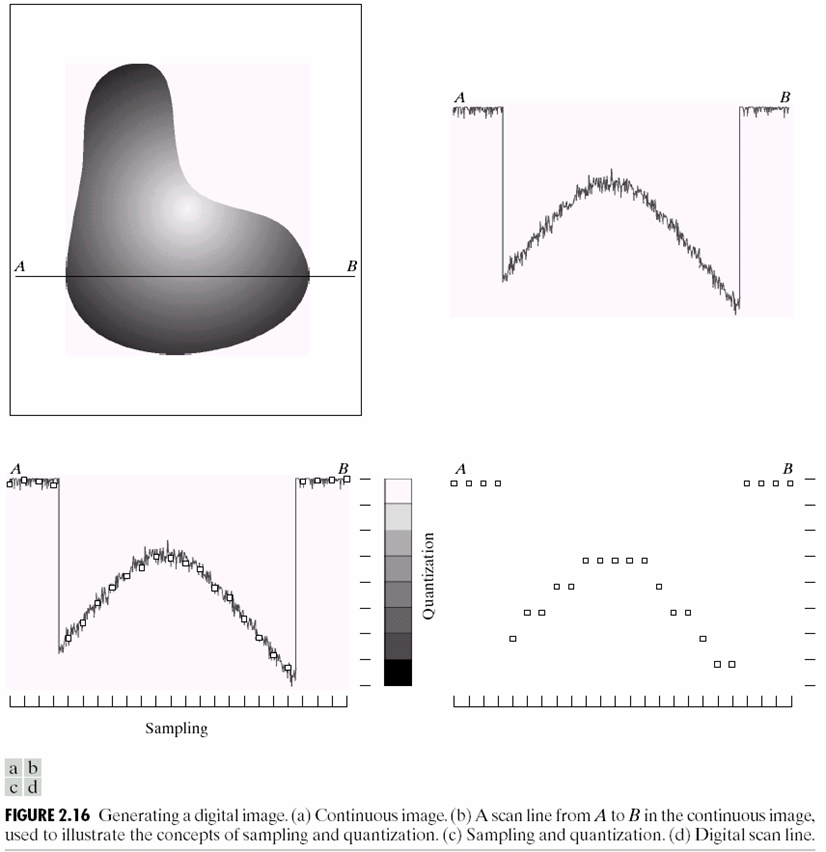Introduction
This paper aims to explain the different steps that are involved in the processing of a digital image. This paper will begin with the first process which is capturing the image using a device. The second part of this paper will discuss the process of acquiring a digital image.
Question A1.1
Fundamental steps in digital processing.
Some of the most important steps that are involved in the processing of digital images will be listed and explained here.
Image acquisition
“This is the process where the digital image is captured using a device. The acquisition process is different and it is determined by the kind of applications used” (Gonzalez, 45). There is a pre-processing stage that is used at this juncture. This involves sampling the quantization which helps to convert an image that is continuing into a digital one. The second question will give the details of image acquisition.
Image enhancement
This is the stage that involves changing, adjusting, and modifying the image so that it can be customized for a specific application or process. Question number four has an example of an image enhancement given through the histogram equalization. In this stage, the contrast of the given output image is more suitable and pleasant as opposed to the input one.
Image restoration
This is a process that is done to produce an output image that is of better quality. Unlike in the previous process, this process can be explained to be objective. This is because it is the user who can define how a good image should look like. Image enhancement is subjective because its fitness and specifications are determined by mathematical theories or other formal standards.
Colour imaging
This is the process of coloring the image. It is performed on colored images. In many circumstances, the color imaging methods that are used in grayscale images can also be used to color images. However, there is the possibility of using methods that are specialized in color imaging depending on the application being used.
Wavelets
These can be defined as varying methods that are used to make a representation of images in compressed form. They change or transform the different images into smaller dimensions and thus ensuring that the computation efficacy is achieved.
Compression
Due to the increase in the number of people using the web and multimedia distribution over the past few decades, the use of compression in images has been enhanced. “Image compression can be defined as the process of compressing images and therefore storing or representing them in less memory than they were initially” (Burger, 17). This helps to save space in a storage device.
Morphological image processing
This is a process that involves the extraction of the image components that are about the representation and the description of the shape of the images.
Segmentation
This is the process that involves dividing an image into several parts. This ensures that one can identify the different regions which belong to different objects in an image. A simple example that involves segmentation is background subtraction which involves the segmentation of the background and the foreground of an image.
Recognition
The process that is used to recognize and identify the different features, faces, and objects falls under the recognition category.
Acquisition of digital image
In the illustration, a continuous image is captured and it is continuous in both the coordinate and amplitude axis. “For the extraction of a digital image from the continuous image to be done, the continuous image should be digitized in the x and y coordinates and also the amplitude should be digitized” (Sonka and Boyle, 90). The process of digitizing the x and y coordinates is called sampling while the process of digitizing the amplitude of the specific coordinate axis is the quantization process. When sampling, the x and y coordinates are given a discrete value, and in the quantization process, the image intensity is given a discrete value.
If this was to be analyzed theoretically then we can see that there is a continuous number of the x and y coordinates and the intensity values. However, when analyzed practically, we see that the continuous image is replaced by a stripe of sensors and hence the values are dependant on the number of the sensors that are in the stripe. The levels of quantization or the grayscale values in the digitization intensity usually depend on the number of bits that are available in each pixel. For example, if there are eight bits then there can be two hundred and fifty-six intensity values that range from zero to two hundred and fifty-five.

Conclusion
This paper has discussed the important steps that are involved in the processing of images. These steps have been described in details and they have showed the whole process which begins with the actual capturing of the image to the modification of the image. In the second part, this paper has discussed in details how a digital image is acquired.
Works cited
Burger, Wilhelm. Digital Image Processing: An Algorithmic Approach Using Java. London: Springer, 2007.
Gonzalez, Richard. Digital Image Processing. London: Prentice-Hall, 2002.
Sonka, Milan and Boyle, Roger. Image Processing, Analysis, and Machine Vision. London: PWS Publishing, 1999.